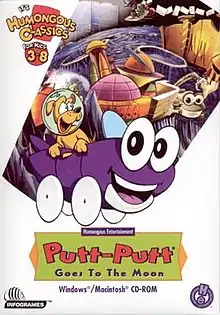Putt-Putt Goes to the Moon
Putt-Putt Goes To The Moon is a 1993 video game and the second of seven adventure games in the Putt-Putt series developed and published by Humongous Entertainment. It is also the last game in the series to use pixel art graphics.
| Putt-Putt Goes to the Moon | |
|---|---|
 Rereleased Windows / Macintosh cover art | |
| Developer(s) | Humongous Entertainment |
| Publisher(s) | Humongous Entertainment[lower-alpha 1] |
| Director(s) | Ron Gilbert |
| Designer(s) |
|
| Writer(s) | Laurie Rose Bauman Annie Fox |
| Composer(s) | George Sanger |
| Engine | SCUMM |
| Platform(s) | MS-DOS, 3DO, Macintosh, Windows, Linux, Steam |
| Release | 1993: MS-DOS 1994: 3DO 1995: Mac, Windows May 5, 2014: Linux May 5, 2014: Steam[1] |
| Genre(s) | Adventure |
| Mode(s) | Single-player |
Plot
Putt-Putt and Pep are invited by Mr. Firebird, a scientist friend of theirs, to visit his Fireworks Factory. While there, Putt-Putt enjoys making fireworks when a butterfly enters the factory through an open window. Pep chases the butterfly, but inadvertently pulls a lever that causes a firecracker to emerge. Putt-Putt ends up riding on the firecracker and is flown into outer space. After floating in space for a little bit, Putt-Putt lands on the Moon and wonders how he can return home to Cartown.
As Putt-Putt explores the Moon, it becomes apparent that someone is spying on him. Soon, Putt-Putt drives on a bridge that breaks and he ends up falling in a lake of "moon goo". He honks his horn to call for help and a lunar rover called Rover (who was the one watching Putt-Putt) rescues him and fixes the bridge. Rover tells Putt-Putt about his backstory as a lunar rover, who was brought from Earth by astronauts but was left behind when the astronauts returned to Earth, with a picture of the Moon being all he had (which he gives to Putt-Putt). Rover gets the idea to buy a rocket ship for sale (which was turned into an ice cream stand) and takes Putt-Putt to Moon City, where the rocket is. To buy it, they need ten "glowing moon crystals" (which acts as Moon City's currency), as well as the rocket's nose cone, the steering wheel to steer the rocket, the rocket fuel and the key to start the rocket up. Putt-Putt and Rover then set out to find all the missing rocket parts.
Putt-Putt receives glowing Moon crystals from a group of aliens called the Crater Creatures by playing Alien Tag, gives the Man in the Moon the picture of the moon that Rover had for a nose cone, helps Rover reach a steering wheel on a high cliff, gets rocket fuel from Robbie Radar at the Gas Station and gets a key as a reward for doing a good deed (rescuing an alien from the moon goo). Putt-Putt buys the rocket with the Moon crystals and gets it all set up. After everything is all set, Putt-Putt and Rover enter the rocket and it blasts off and lands back in Cartown. The citizens of Cartown witness this and are relieved to see that Putt-Putt is alright. Putt-Putt introduces the cars to Rover, and everyone celebrates Putt-Putt's return as nighttime comes and the Moon appears.
Gameplay
The game uses the same mechanics as its predecessor including Putt-Putt's glove box inventory window, Car Horn, Radio and Accelerator. Glowing moon crystals replace coins from the first game as the use of currency in the game, in which you can earn up to 5 glowing moon crystals by playing a minigame called "Alien Tag", with a group of aliens called the crater creatures; 10 crystals must be earned in order to purchase the rocket ship to return to Earth.
Release
The 3DO version of the game was shown at the Winter Consumer Electronics Show in Las Vegas around early January 1994.[2] Copies of the game came packaged with an activity book containing Math and English exercises plus a Putt-Putt pen.[3]
Reception
| Publication | Award |
|---|---|
| Choosing Children’s Software | 1999 Best Picks for the Holidays Award[4] |
| Anders CD-ROM Guide | 1997 Medallion Award[4] |
| Parents' Choice | 1994 Honor Award[4] |
| Home PC | Top 100 Products[4] |
| Multimedia World | Best Children’s Title[4] |
| The National Parenting Center | Seal of Approval[4] |
| MacUser | Four Mouse Award[4] |
| CD-ROM World | The CD-ROM 100 Best[4] |
| CES | 1994 Innovations Showcase Award Winner[4] |
In April 1994, Computer Gaming World said that the game "offers a classic adventure experience for children (and adults)".[5]
The combined sales of Putt-Putt Goes to the Moon, Putt-Putt Joins the Parade and Putt Putt Saves the Zoo surpassed one million units by June 1997.[6]
References
- "Putt-Putt Goes to the Moon on Steam". Steam. Retrieved May 20, 2015.
- "Global Launch multiple brands more than 200 titles in Development". Game Guru - Volume 1, Issue 1. March 1994. Retrieved November 4, 2017.
- "Edutainment - Two of the Best". PC Zone. No. 15. Future plc. June 1994. p. 91.
- "Humongous Entertainment® Hall of Fame 1993-2000": 10.
{{cite journal}}: Cite journal requires|journal=(help) - "Invasion Of The Data Stashers". Computer Gaming World. April 1994. pp. 20–42.
- People Staff (June 2, 1997). "The Little Car that Could". People. Archived from the original on May 19, 2018.
- The Steam release was co-published by Tommo and Night Dive Studios.